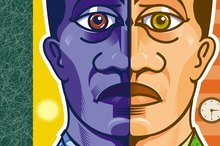What does fact checked mean?
At Healthfully, we strive to deliver objective content that is accurate and up-to-date. Our team periodically reviews articles in order to ensure content quality. The sources cited below consist of evidence from peer-reviewed journals, prominent medical organizations, academic associations, and government data.
The information contained on this site is for informational purposes only, and should not be used as a substitute for the advice of a professional health care provider. Please check with the appropriate physician regarding health questions and concerns. Although we strive to deliver accurate and up-to-date information, no guarantee to that effect is made.
ADHD Exercises & the Dore Method
ADHD, or attention deficit hyperactivity disorder, is a term used to describe a disorder with symptoms of inattentiveness, hyperactivity or both 1. The Dore method is a program for tackling a broad spectrum of learning difficulties and ADHD through exercises targeted at stimulating and improving the functioning of the cerebellum. Dore believes that the root cause of ADHD symptoms lies in the cerebellum.
About ADHD
ADHD is a common disorder, usually diagnosed in childhood, that results in primary symptoms of inattentiveness and/or hyperactivity. Children diagnosed with ADHD typically have problems with impulse control and self-regulating behaviors. ADHD has three subtypes. The first is referred to as predominantly hyperactive and impulsive, followed by predominantly inattentive and combined hyperactive-impulsive and inattentive. Children with ADHD are easily distractable. They tend to have difficulty paying attention to basic instructions given at home or school, become easily bored, daydream and appear not to listen when spoken to.
- ADHD is a common disorder, usually diagnosed in childhood, that results in primary symptoms of inattentiveness and/or hyperactivity.
- Children diagnosed with ADHD typically have problems with impulse control and self-regulating behaviors.
ADHD Treatment and Conventional Exercises
Exercises for Oppositional Defiant Disorder
Learn More
ADHD is typically treated with a combination of medication, psychotherapy, education and training, or a combination of one or more of these treatments. Medications that are commonly used generally fall into the categories of amphetamines and methylphenidatess. Additionally, psychotherapy focusing on behavior management and the development of social skills is frequently recommended to help children accomplish basic tasks, manage their time and develop meaningful relationships with others, as well as to educate parents or caretakers about methods for dealing with their child's behavior. Exercises on behavior and time management may be provided by the therapist, such as creating a structured time for homework and playtime, a routine for bedtime, and so on. Other treatment modalities have been developed in the past few decades, including the Dore method and sensory-integration therapy, which focus on different theories regarding the cause of ADHD.
- ADHD is typically treated with a combination of medication, psychotherapy, education and training, or a combination of one or more of these treatments.
- Other treatment modalities have been developed in the past few decades, including the Dore method and sensory-integration therapy, which focus on different theories regarding the cause of ADHD.
About the Dore Method and Exercises
The Dore method is a somewhat controversial therapy for ADHD and other learning disorders that is based on the theory that these disorders originate due to a delay in the cerebellum. The Dore method purports to treat ADHD through the performance of daily exercises, which are recommended to be performed for 10 minutes, twice a day. According to Bruce F. Pennington, Ph.D., in his book "Diagnosing Learning Disorders," the exercises are thought to cure the delay in the cerebellum 2. The exercises focus on the development of cognitive and motor skills. The Dore method is offered at various learning institutions and psychological centers across the U.S. It is a rather expensive treatment, averaging around $3,000, according to a 2006 interview with founder Wynford Dore on Myomancy.com, a website dedicated to the science and treatment of ADHD, autism and dyslexia 3.
Warning
What Is Morbid Depression?
Learn More
Clinical studies supporting the Dore method have not been independent. Rather, the two studies that are available, published in 2003 and 2007 editions of the journal "Dyselexia," were written by proponents of the Dore method, according to Pennington. The Dore method must therefore be used with caution, since it has not been empirically evaluated by independent investigators.
Related Articles
References
- National Institute of Mental Health: Attention-Deficit Hyperactivity Disorde
- "Diagnosing Learning Disorders"; Bruce F. Pennington, Ph.D.; 2008
- Myomancy.com: Ask Wynford Dore: The Ten Answers
- Epstein JN, Loren REA. Changes in the Definition of ADHD in DSM-5: Subtle but Important. Neuropsychiatry . 2013;3(5):455-458. doi:10.2217/npy.13.59
- Barkley RA. Taking Charge of Adult ADHD. 1st edition. The Guilford Press; 2010.
- Wilens TE, Biederman J, Faraone SV, Martelon M, Westerberg D, Spencer TJ. Presenting ADHD symptoms, subtypes, and comorbid disorders in clinically referred adults with ADHD. J Clin Psychiatry. 2009;70(11):1557-1562. doi:10.4088/JCP.08m04785pur
- American Psychiatric Association. Diagnostic and Statistical Manual of Mental Disorders (5th Ed.). Washington, DC. 2013
- Barkley R. (2010) Taking Charge of Adult ADHD, The Guilford Press 2010
Writer Bio
Ashley Miller is a licensed social worker, psychotherapist, certified Reiki practitioner, yoga enthusiast and aromatherapist. She has also worked as an employee assistance program counselor and a substance-abuse professional. Miller holds a Master of Social Work and has extensive training in mental health diagnosis, as well as child and adolescent psychotherapy. She also has a bachelor's degree in music.









